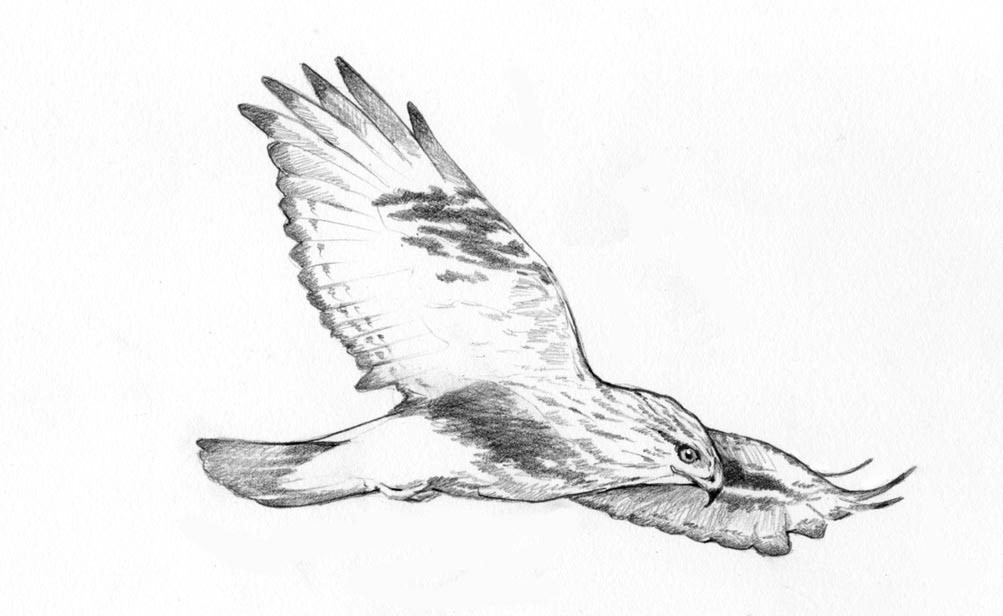
Winter can be a lean time for birders. The vast majority of our avian diversity has moved south, and watching the few species that visit our birdfeeders from the comfort of a cozy living room often seems like the best option, compared to birding in a frigid north wind. However, periodic invasions of raptors from the far north can often make winter birding a little more exciting, if not any warmer. While most of these southward irruptions of northern hawks and owls occur in regular three- to five-year cycles, predicting exactly when they will invade New England is about as reliable as predicting our winter weather patterns.
Like so many cycles in the natural world, patterns of winter raptor invasions are driven by the same things that drive much of our daily lives: sex and food. Okay, mostly food, but reproductive success plays a role for some species. There are five species of arctic and boreal raptors that periodically “irrupt” south into the northern United States: rough-legged hawk, snowy owl, great grey owl, northern hawk owl, and boreal owl. As predators, all of these species are dependent, to varying degrees, upon small mammals (particularly voles and lemmings) as a critical food source. The largest and most powerful of these birds is the snowy owl, a generalist predator of the arctic tundra capable of taking advantage of a wide variety of prey, ranging from small mammals to arctic ground squirrels, hares, ptarmigan, and other birds. At the other end of the spectrum is the tiny boreal owl, which, as its name implies, occupies the boreal forest zone and specializes in preying on small mammals, primarily the red-backed vole.
Across the North American tundra (generally north of 60 degrees north latitude), arctic raptor populations ebb and flow along with the abundance of lemmings, which fluctuate synchronously on a regular cycle. When lemming numbers are high, raptors such as the snowy owl have more prey to feed their young, resulting in years of high reproductive success. For this generalist predator, southward irruptions often follow these years of high nesting success, not because food in the arctic is scarce, but because snowy owl populations (and those of other predators that feed on lemmings) are extremely high. For snowy owls, the result is that many young owls migrate south into southern Canada and the northern United States, thereby avoiding competition with the more aggressive adult birds, most of which remain in the Arctic.
Among specialist owls, however, southward irruptions are primarily linked to years of low small-mammal populations, particularly the red-backed vole, which undergoes a three- to five-year population cycle. Recent work done by Marianne Cheveau of the University of Quebec, along with several colleagues, demonstrated that large numbers of boreal owls move south every four years when red-backed vole densities are at their lowest. The other two owl species (northern hawk owl and great grey owl) show the same four-year irruptive cycle, but they are less pronounced because both species are larger and occupy a variety of habitats, allowing them to prey on a broader range of species.
The most reliable winter raptor visitor from the north is the rough-legged hawk. A nomadic species that nests in the arctic tundra of Alaska and Canada, rough-legged hawks are migratory, moving south each year to winter in open habitats in southern Canada and the northern United States. It is unclear why, as a migrant to our region every year, this species occasionally exhibits “irruption” years. Intuitively, you would expect these invasions to correspond to years of high reproductive success, like the snowy owl, when there are simply more birds around. But the pattern appears to be more complex, fluctuating regionally across the wintering range, with “invasions” occurring in areas where small rodent prey are abundant. This has led some to theorize that rough-leggeds, like European kestrels (and probably many other hawks), can visually detect areas where rodents are abundant by seeing their scent markings, which are visible in the ultraviolet spectrum that many birds are sensitive to.
The best places to look for these wintering birds of prey are areas of extensive open habitats, reminiscent of their arctic tundra breeding grounds. In Vermont, the fertile agricultural lands of the Champlain Valley, especially around Dead Creek Wildlife Management Area in Addison, provide the most consistent sightings of rough-legged hawks and snowy owls, while in New Hampshire, open marshes and beaches along the seacoast produce reliable results. But, keep in mind that during invasion years, sightings can and do occur almost anywhere across the twin states, and Boston’s Logan Airport is a well-known hotbed for wintering raptors from the far north.

